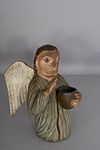txaldzap’am nagyeda laxa (Baptismal Font)
About this object
History of use
According to Methodist missionary Reverend George H. Raley, this carved angel figure was used as a baptismal font in a church in Port Simpson, but was ultimately removed because it frightened children as they were coming into the church.
Narrative
The figure has been inconclusively attributed to Ts’msyen painter Frederick Alexcee. More strongly influenced by the church than by Ts’msyen stylistic conventions, the angel’s sculptural features are unlike any of the known carved works of Alexcee’s, both signed and unsigned. As well, many of those carvings and model poles are painted with compositions clearly of his style. Perhaps it is reasonable to speculate that the angel was linked to Alexcee in the traditional Ts’msyen way of commissioning carved pieces, where the name of the chief, rather than that of the maker, remained primary. Reverend Raley was a missionary appointed to the Haisla community of Kitamaat in 1893 and transferred to Port Simpson in 1906. Throughout those years he built a large collection of Northwest Coast material culture. In 1914 he became principal at the Coqualeetza Indian Residential School in Sardis, B.C., where photos from later years show how he displayed some of his collection there -- including this baptismal font (e.g., see Vancouver Archives: “Dr. Raley’s collection of Indian relics in position at the Coqualeetza Indian Residential School,” 1934).
Iconographic meaning
With its Christian motif, created by a Northwest Coast artist, this carving of an angel illustrates the reverence required of those who converted to the new religion.
Physical description
Large wooden carving of the upper torso of a male angel, holding a bowl. Figure is round at its base (waist), dressed in a blue-grey robe, holding a black bowl with one hand. The other hand is raised, palm out, in benediction. A pair of wings (parts b,c) with the carved feather side painted grey and the other side white with grey painted feathering, attach to the back with pegs.
Materials
Subjects
